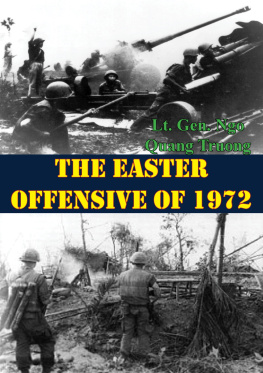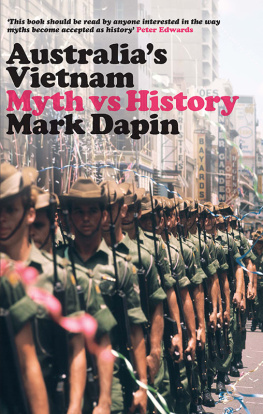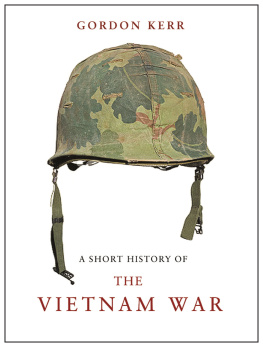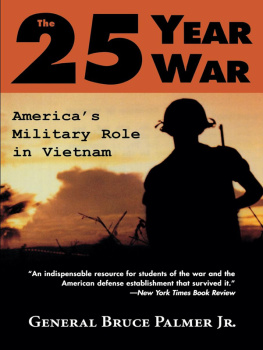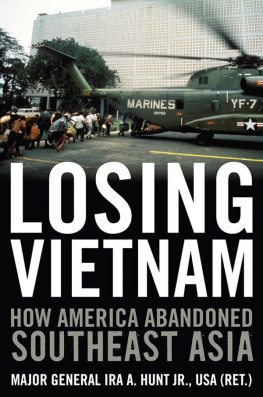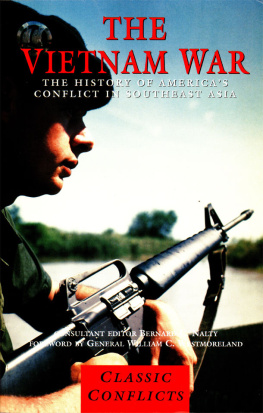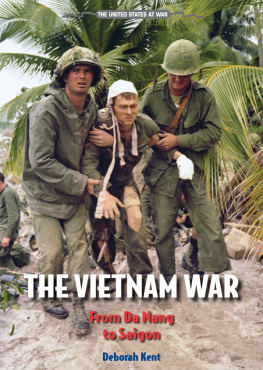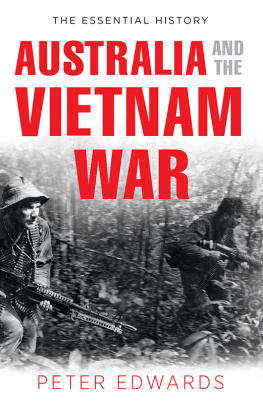 | Australian Army Campaigns Series 3 |
AUSTRALIAN MILITARY OPERATIONS IN VIETNAM
Second Edition
ALBERT PALAZZO


2011
Copyright Army History Unit
Campbell Park Offices (CP2-5-166)
Canberra ACT 2600
AUSTRALIA
(02) 6266 4248
(02) 6266 4044 fax
Copyright 2006 Commonwealth of Australia
First published 2006 Second Edition 2009
Reprinted 2011
This book is copyright. Apart from any fair dealing for the purposes of private study, research, criticism or review as permitted under the Copyright Act, no part may be reproduced, stored in a retrieval system or transmitted in any form or by any means, electronic, mechanical, photocopying, recording or otherwise, without written permission.
National Library of Australia Cataloguing-in-Publication entry
Author: Palazzo, Albert, 1957
Title: Australian military operations in Vietnam
Edition: 2nd ed.
ISBN: 9780980475388 (pbk.)
Series: Australian army campaigns series; 3
Notes: Includes index. Bibliography.
Subjects: Vietnam War, 1961-1975 Participation, Australian.
Vietnam War, 1961-1975 Campaigns.
Dewey Number: 959.7043394
Typesetting by Margaret McNally, Canberra, ACT
Printed by: Big Sky Publishing Pty Ltd, Sydney
Front Cover: AWM EKN/70/0468/VN
Back Cover: AWM FOD/71/0255/VN; THU/68/0273/VN; FAI/70/0169/VN; FOD/71/0305/VN
Title Page: AWM CUN/66/0475/VN
CONTENTS
ACKNOWLEDGEMENTS
In the course of researching and writing Australian Military Operations in Vietnam I incurred debts to a number of institutions and individuals. This work was an initiative of the Army History Unit and its members have my thanks for its place in the Australian Army Campaigns Series. At the Australian War Memorial I must thank the staff of the research centre, in particular David Jolliffe who played a key role in locating vital records. Mr Roger Rees at the Defence Imagery and Geospatial Organisation has my thanks for his provision of topographical maps. I must also thank Captain John Landis of the Royal Australian Infantry Corps Museum for permission to photograph the collections Vietnam era weapons.
A number of specialists have contributed to this book. Mark Wahlert was responsible for the books illustrations and 3-D maps, Kay Dancey and Anthony Bright prepared the 2-D maps, and Jeff Isaacs, OAM, painted the artwork. Research assistance was provided by Jean Bou and Michael Molkentin. Mike also prepared the index. Ian Kuring provided insight into weaponry and shared his experience with MATT. Glenn Wahlert contributed the weapon data inserts. The cover design was the work of Catherine McCulloch of Defence Publishing Service.
My wife, Melissa Benyon, once again read and commented on the books draft. My son, Thomas Palazzo, analysed the companion computer game and provided youthful insights into its playability. Cathy McCullagh undertook the books copyedit, and Margaret McNally did the typeset.
The books development was materially eased by the efforts of Glenn Wahlert, the project manager of the Australian Army Campaigns Series. Again, Glenn has my thanks.
Albert Palazzo
Consultant Historian, Canberra
August 2006
ACKNOWLEDGEMENTS SECOND EDITION
The author would like to thank Roger Lee of the Army History Unit for the opportunity to write a second edition of this book. Several people have played a key role in its revision. In particular the author would like to acknowledge the assistance of Ian Kuring, Mark Wahlert, Margaret McNally, Albert M. Palazzo and Melissa Benyon.
Albert Palazzo
Senior Research Fellow
Land Warfare Studies Centre
November 2008
AUSTRALIAN MILITARY
OPERATIONS IN VIETNAM
THE ORIGINS OF THE VIETNAM CONFLICT
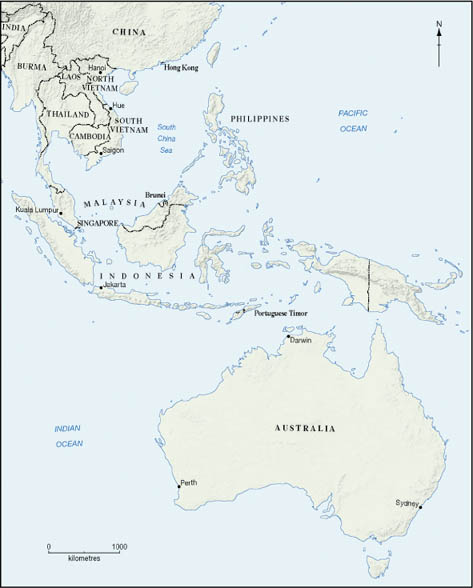
Australia and South-East Asia. Anthony Bright.
Background to the Vietnam War
The origins of Australias involvement in the Vietnam War lay in the collapse of French authority over the region during and after the Second World War. European contact with Vietnam dated from the 16th century with the arrival of merchants and missionaries. It was not until 1858 that France began a military conquest of Vietnam and the adjoining kingdoms of Cambodia and Laos, a process which it did not complete until 1893. The French divided their possessions into five colonies and protectorates: Cochinchina, Annam, and Tonkin (together making up Vietnam), Cambodia and Laos. French control of Vietnam was, therefore, a relatively recent event, and came about only through the displacement of long-standing indigenous sovereignty.
In their short time as the colonial masters of South-East Asia the French did not develop an enviable reputation. Naturally, they ruled for the benefit of Paris, directing Vietnams wealth to France while using the region as a market for the home countrys manufactured goods. Colonial administrators forced villagers off their land in order to provide labour for plantations and mines, and kept the peasants in poverty through high taxes, exorbitant rents, and exploitation by rice brokers. The French also sought to break down Vietnamese local identity by imposing European language, culture and religion.
Opposition to the French was feeble, and the Europeans quickly and brutally suppressed the few rebellions that did erupt. The colonial government also suppressed indigenous-based political parties and forced them underground. One of these parties was the Indochina Communist Party that Ho Chi Minh founded in 1930. Ho was a charismatic leader, and the partys call for national independence and social equality were well-aimed policy goals. The Indochina Communist Party remained an insignificant force throughout the 1930s, its members numbering only in the hundreds and scattered across South-East Asia. However, it would be the communists who would become the eventual rulers of Vietnam, emerging victorious from lengthy wars against first France and then the United States.
The Indochina Communist Party took advantage of the power vacuum created in Indochina by the Second World War to advance its cause. In 1940, after a brief campaign, France fell to Nazi Germany leaving its Indochinese territories vulnerable to a militarist and expansionist Japan. The Japanese were quick to act on French weakness. At first Japan demanded only concessions such as port access from Indochinas colonial administrators, but gradually its forces occupied all of South-East Asia. For most of the Pacific War the French technically continued to administer Indochina, but their control was a thin veneer behind which lay Japanese military might. This arrangement suited the Japanese, who did not fully remove the French until almost the end of the war. However it tainted the colonial administrators as collaborators.
In May 1941 Ho founded the Viet Minh (Front for the Independence of Vietnam) which became one of the leading opposition groups to the Japanese and their French lackeys. Espousing Vietnamese nationalism, the Viet Minh sought the withdrawal of both foreign overlords and the establishment of an independent nation. At its peak, and with some aidalbeit slightfrom the American Office of Strategic Services, the Viet Minh controlled only a small part of Vietnam. Its authority extended only as far as the mountainous provinces of Tonkin near the border with China. Ho avoided military confrontation because he did not want to risk annihilation, a fate which befell other Vietnamese resistance groups. Instead, the recruitment of cadres and the building of an organisation were his priorities.



